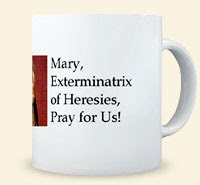
Last week I came across yet another argument for gay marriage. It is noteworthy because it is not couched in the usual political language of equal rights and personal autonomy; the use of such language assumes that it is up to the state to define (as distinct from regulate) marriage, and is thus question-begging when not completely irrelevant. But the argument of note is, in effect, that on an orthodox understanding of the relationship between Christ and the Church, same-sex marriage is every bit as sacramental as marriage in the ordinary sense. That is quite relevant. It is also profoundly deceptive.
The author, Todd Bates, summarizes the argument as follows:
1. Christ was resurrected in the flesh, and will exist in the world to come.Now Bates takes some care to explain each step, and I shall not presume to gainsay the explanation. (It is, after all, his argument.) He seems to believe that one of the argument's key advantages is its sharing its premises with otherwise orthodox (what CS Lewis called "mere") Christian theology. That seems to put the burden on the mere Christian to show why the conclusion doesn't follow. And that burden is daunting, since Bates' argument appears to be formally valid. But the difficulty with the argument is not hard to specify; ironically, it is with the one premise that Bates seems to think requires no explanation.
2. In the world to come, members of the Church will be resurrected, male and female, in the flesh.
3. In the world to come, the members of the Church will bear a new real, reciprocal relation to Christ; call it R.
4. Here below, marriage should be modeled on R.
5. R obtains between males: for instance, Christ and each blessed male.
6. As R obtains between males, and marriage is to be modeled on R, marriage may obtain between males.
The difficulty is with (5): specifically, (5) is ambiguous. It does not distinguish between Christ's relation to members of the Church taken collectively and taken severally. It assumes that relevant relation holding between Christ and the Church qua whole is exactly the same as that holding between Christ and each member of the Church qua individual. In context that assumption is easy to make, inasmuch as the union-in-love that will obtain in the Eschaton between Christ and the Church qua whole will certainly be manifest in how it obtains between Christ and each saved human. But from the fact that marriage is a sacramental sign and foreshadowing of R, and that R will obtain between Christ and the Church qua whole, it does not follow that precisely R will obtain between Christ and each member of the Church individually. Indeed one cannot assert, as a general proposition, that any relation holding between a given x and some whole W is exactly the same as that holding between x and each part of W. Such identities can and do sometimes obtain, but not always by any means. And so (5) is far from trivial: Bates needs an argument to show that the relevant relation between Christ and each individual member who is saved will be exactly the same as that which will hold between Christ and the Church qua whole.
The first thing such an argument would have to show is that same-sex marriage, contra the tradition and teaching authority of the Church as well as Scripture's condemnation of sodomy, is in fact possible. In the context of mere Christianity, that is no small task. In fact there are good grounds for holding that same-sex marriage is impossible; see William May's On the Impossibility of Same-Sex Marriage.
Bates needs a dose of John Paul II's "theology of the body"—as do Christians in general today. It is so much more profound and healthy a vision of human sexuality than most of what we get these days.

























